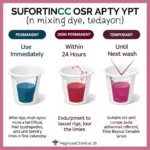Food coloring is a common household item, and you might be wondering, can you use food coloring for tie dye? While it seems like a convenient and inexpensive option, using food coloring for tie dye isn’t generally recommended. We’ll explore the reasons why and offer better alternatives for vibrant and long-lasting tie-dye projects. Check out this guide on how to preserve color run shirt for tips on keeping your vibrant colors.
Why Food Coloring Isn’t Ideal for Tie Dye
While food coloring might seem like a readily available and cost-effective option for tie dye, it has significant drawbacks that make it unsuitable for creating vibrant, lasting designs. The primary issue lies in its chemical composition. Food coloring is water-based and not designed to bind to fabric fibers like dedicated fabric dyes.
Food Coloring Fades Quickly
Because food coloring doesn’t bond effectively with fabric, the colors will wash out quickly, often after just one wash. Your vibrant creations will fade into pale, disappointing shadows of their former selves. This lack of colorfastness makes food coloring a poor choice for tie dye, especially if you want your designs to last.
Achieving Vibrant Colors with Food Coloring Is Challenging
Even before washing, achieving deep, rich colors with food coloring can be difficult. The colors tend to be pastel and less intense than those achieved with proper fabric dyes. This is because food coloring is designed for coloring food, not fabric, and lacks the necessary chemical properties for strong color saturation on textiles.
Potential for Uneven Dyeing
Food coloring can also lead to uneven dyeing. Because it doesn’t bind well to the fabric, it tends to spread and bleed unpredictably, resulting in blotchy or patchy results rather than the crisp, defined patterns you’d expect from tie dye.
Best Alternatives to Food Coloring for Tie Dye
So, what can you use instead of food coloring? There are several excellent dye options specifically formulated for fabric that will provide vibrant, long-lasting results.
Fiber Reactive Dyes
Fiber reactive dyes are the gold standard for tie dye. They chemically bond with the fabric fibers, creating vibrant, permanent colors that won’t fade easily. These dyes are available in a wide range of colors and are perfect for creating bold, eye-catching designs.
All-Purpose Dyes
All-purpose dyes are another good option, although they may not be as colorfast as fiber reactive dyes. They are easier to use and are suitable for various fabrics. Be sure to follow the manufacturer’s instructions carefully for the best results.
Natural Dyes
For a more eco-conscious approach, consider natural dyes derived from plants, fruits, and vegetables. While the color palette might be more limited, natural dyes offer a unique aesthetic and are a sustainable alternative. You may need to experiment to achieve desired color intensity.
Tips for Successful Tie Dyeing
Regardless of the dye you choose, following these tips will help you achieve the best results:
- Pre-wash your fabric: This removes any sizing or finishes that might interfere with dye absorption.
- Soak the fabric in soda ash solution (for fiber reactive dyes): This helps the dye bind to the fabric.
- Use rubber bands or string to create your desired patterns.
- Apply the dye carefully and evenly.
- Let the dye set for the recommended time.
- Rinse thoroughly and wash separately. Learn how to remove unwanted stains from your hands after dyeing with this guide: how to remove food coloring from hands.
Conclusion
While the question “can you use food coloring for tie dye?” might cross your mind, it’s best to opt for dedicated fabric dyes for vibrant, lasting results. Fiber reactive dyes are the ideal choice, offering superior colorfastness and a wide range of colors. By using the right materials and following proper techniques, you can create stunning tie-dye projects that you’ll cherish for years to come. Consider if can food coloring stain clothes and take precautions.
FAQ
- What is the best type of dye for tie dye? Fiber reactive dyes offer the best colorfastness and vibrancy.
- Can I tie dye synthetic fabrics? Yes, but you’ll need dyes specifically designed for synthetic fibers.
- How do I prevent the colors from bleeding? Use quality dyes and follow the rinsing and washing instructions carefully.
- How long should I let the dye set? Follow the manufacturer’s instructions for your specific dye.
- What can I use to tie the fabric? Rubber bands, string, or even zip ties can be used to create patterns.
- Can I mix different dye colors? Yes, but be mindful of color theory to achieve the desired results.
- How do I set the dye permanently? Washing the dyed fabric in hot water with detergent helps to set the color.
Common Tie Dye Scenarios
- Bleeding colors: This can happen if the dyes aren’t properly rinsed or if low-quality dyes are used.
- Uneven dye distribution: Make sure to apply the dye evenly and thoroughly saturate the fabric.
- Fading after washing: Using proper fabric dyes and following the washing instructions will help prevent fading.
Further Exploration
Looking to experiment with other color modifications? You might be interested in exploring can you add bleach to colored clothes. You can also learn more about using food coloring for tie-dyeing specifically at can you use food coloring for tie dying.
Need assistance with your tie-dye projects? Contact us at 0373298888, email [email protected], or visit our store at 86 Cầu Giấy, Hà Nội. We offer 24/7 customer support.
